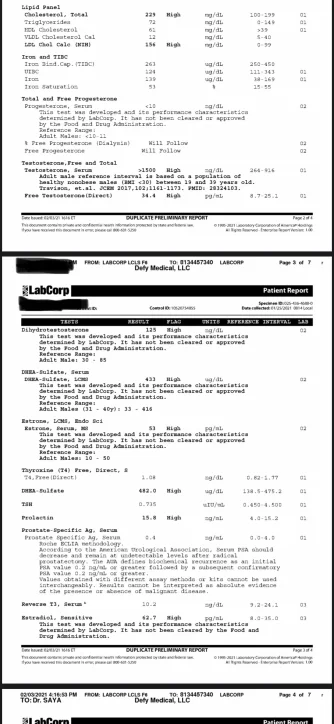madman
Super Moderator
Speaking on supraphysiological Test levels do we even know what early Homo sapiens levels were?
Is it crazy to hypothesize they could have had test levels well into the 2000’s and we are merely “getting by” due to living in a civilized modern society. Meaning through evolution we don’t need such high test levels due to our more social nature put upon us as part of living in a modern society.
We see it in primates. Bonobos for instance don’t have as much testosterone due to their more social nature. Male chimps on the other hand have crazy high hormone levels because they aren’t as social and they often resort to killing other chimps to solve problems. They are quite violent primates.
Maybe we are fixated on TT and FT levels via TRT that do not serve us well. Maybe We are woefully “low” when it comes to levels that helped early man stay lean, strong, aggressive (in a good way for hunting etc) and with sex drives that enabled them to ravish women or men (full consent lol) all day long?
I don’t know. Perhaps our hormones have changed and/or adapted to living as civilized human beings and it is all to our detriment. Did our grandparents, great grandparents etc deal with low Test? Maybe? Maybe not? I wonder how far back male hormone levels were tracked. When did these tests come available and are we in fact continuing a steep decline in male hormone levels? What are healthy good numbers that everyone should strive for to get us back to feeling whole? Whole as in a sense of well being with a libido that is off the charts.
I know where my numbers are and I feel the best I’ve ever felt. A little distracting, ok a lot, with a crazy high libido but the other side of that coin isn’t where I ever want to be again.
In the early 1970s and healthy young males were averaging TT 600-800 ng/dL.
Unfortunately, when it comes to libido let alone ED they are multifactorial and there is much more involved than just having healthy hormones (TT, FT, estradiol, DHT, prolactin).
Underlying vascular health is critical!
Having healthy testosterone levels is beneficial to one's libido/erectile function but it is far from the only thing that is required to having a healthy libido.
Thyroid/adrenals, neurotransmitters, insulin sensitivity, stress (mental/physical), quality of sleep, diet, underlying vascular health to name a few can all have a big impact on one's libido/erectile function.
Libido/ED is much more complex than simply having healthy testosterone levels.
Even then when it comes to trt and libido many tend to get caught up in thinking that it will be through the roof once they hop on trt and get to the point of so-called dialed in let alone cure any ED issues they may have.
When you find that happy place you should have a healthy libido not raging, savage, insane.
There are many men who will see an improvement in libido, others will continue to struggle, some may even end up worse off than before trt and some of the lucky ones will see a drastic improvement.
I think too many get caught up in expecting to feel great 24/7 once on trt as if testosterone is going to cure all that ails them.
davidrn said:
"The normal range of testosterone is reported as 350- 1200ng/dl. Studies in the 1940's showed the average testosterone level to be at 700 ng/dl, 300 ng/dl higher than for men today. In the past, a drop in testosterone levels to 250 ng/dl was rarely reported before men were 80 years of age. Yet today, it is not an uncommon value for middle aged men! "
I also have seen mention (assume this is estimated) that slim tradesmen as recent as a hundred years ago had levels up to the 2000 range. In my town, Italian stone workers built loose stone walls with little equipment in the 1870's, looking at pictures of these men, you realize how strong and wiry they were. What they weren't, was built like contemporary bodybuilders.
My reply to a previous member (davidrn) thread:
There were no accurate testing methods decades ago.....let alone testing methods in the 1940s.
Serum Testosterone Assays—Accuracy Matters (2004)
The routine clinical use of T assays began approximately 30 yr ago with the development of RIAs for T that could be performed on relatively small quantities of blood after organic extraction and chromatographic separation (1). Subsequently, there have been remarkable advancements in immunoassays for T as well as other hormones. Compared with original RIAs, T assays of today are more sensitive and specific, require smaller quantities of serum, do not involve extraction or chromatography, and are performed more rapidly and with less cost. In most large clinical chemistry and many reference laboratories, T assays are performed routinely on automated platforms using non-radioactive methods.
http://eknygos.lsmuni.lt/springer/516/63-72.pdf
The first RIA method, developed in 1959 by Yallow and Berson (1,2), was for insulin. Ten years later, Abraham (3) reported the development of the first steroid RIA, which was for estradiol (E2). The immediate impact of the RIA method allowed measurement of an immensely wide range of compounds of clinical and biological importance and opened new horizons in endocrinology.
I also have seen mention (assume this is estimated) that slim tradesmen as recent as a hundred years ago had levels up to the 2000 range.
That would be based off he said/she said!














